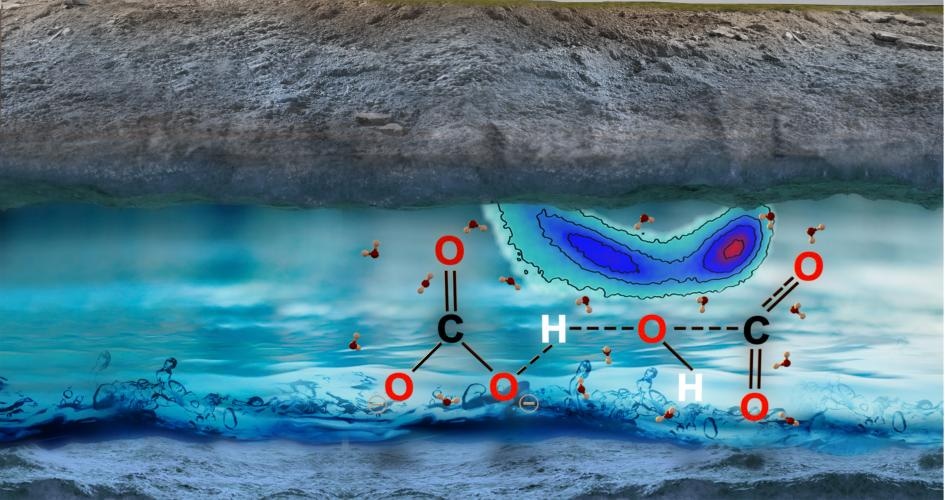Understanding how carbon dissolves in water at the molecular level under extreme conditions is critical to understanding the Earth's deep carbon cycle--a process that ultimately influences global climate change.
 Carbon in the fluid of the Earth’s mantle is not in the form of carbon dioxide but rather in carbonate and bicarbonate ions, researchers found. (Credit: Prof. Giulia Galli, et al)
Carbon in the fluid of the Earth’s mantle is not in the form of carbon dioxide but rather in carbonate and bicarbonate ions, researchers found. (Credit: Prof. Giulia Galli, et al)
Contrary to current geochemical models, the carbon dissolved in water-rich fluid at the bottom of the Earth's upper mantle is not in the form of carbon dioxide but rather in carbonate and bicarbonate ions. That is the conclusion of scientists at UChicago's Institute for Molecular Engineering, who simulated the fate of dissolved carbon dioxide under high pressures and temperatures in the upper mantle, about 410 miles below the surface of the Earth. Their results were published in the Oct. 12 issue of Science Advances.
"Experiments at these extreme conditions remain very difficult, both in execution and interpretation," said Giulia Galli, senior investigator of the paper and the Liew Family Professor of Molecular Engineering. "Fortunately developments in theory and increases in computing power have recently made it possible to use molecular dynamics simulation to investigate water and carbon at extreme conditions."
The work shows that carbon can assume unexpected forms in the fluids found in pores and cracks of rocks deep underground, said Russell J. Hemley, research professor at George Washington University, who was not involved in the research. Therefore, scientists cannot use observations at the surface of the Earth as a guide for how carbon behaves below the surface of the Earth.
"This is important because the different forms could lead to different kinds of reservoirs of carbon-containing materials at depth in the planet," Hemley said. "Calculations such as the ones in this study, together with new experiments prompted by these theoretical results, may be key in determining how much carbon is in the planet."
The researchers also determined that the carbonate and bicarbonate anions under extreme conditions exchange protons with water over picoseconds, or one trillionth of a second. The study suggests that in the upper mantle, water transports carbon mostly through highly active ions, not through dissolved carbon dioxide molecules.
"Our current research suggests the presence of more carbonate and bicarbonate ions than previously thought," said Ding Pan, the paper's first author and a former researcher at the Institute for Molecular Engineering, now assistant professor of physics and chemistry at the Hong Kong University of Science and Technology.
"This presence of ions rather than molecules is a game-changer," said Craig E. Manning, professor of Earth and space sciences at the University of California Los Angeles, who was not involved in the research. "The addition of molecular CO2 to water makes the water less chemically reactive, suppressing the ability of water to strip elements from rock and move the elements to other localities. However, if CO2 reacts with H2O to form anions, then the same amount of carbon makes the water more chemically active, thereby promoting its ability to move elements."
Whether carbon accumulates in the Earth's interior is still a subject of debate, and the chemical reactions of carbon in the deep Earth are not yet fully understood. This research will cause scientists to re-evaluate the role of carbon dioxide in deep fluids and to rethink its mass transfer capability. It also will stimulate the development of new models.